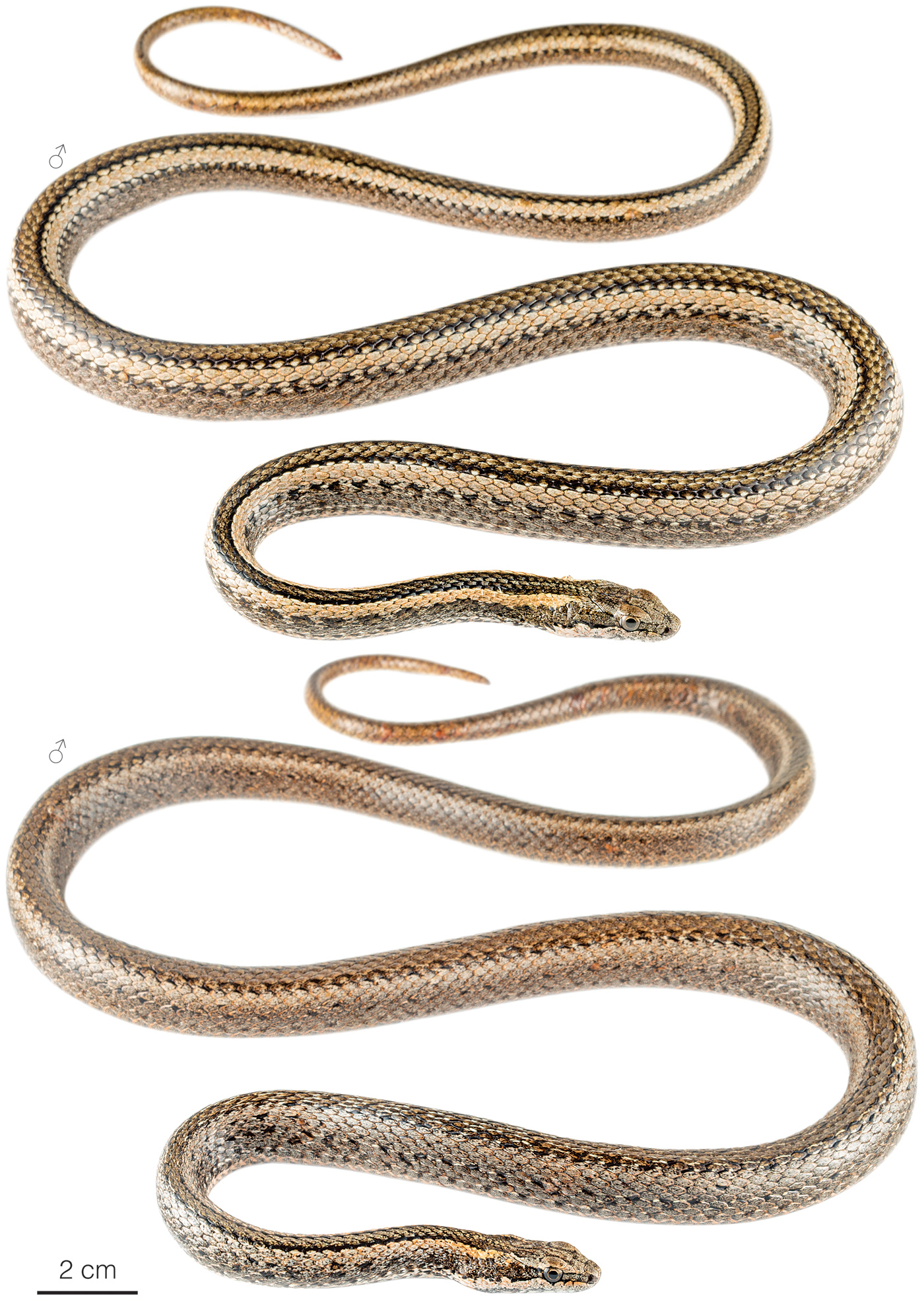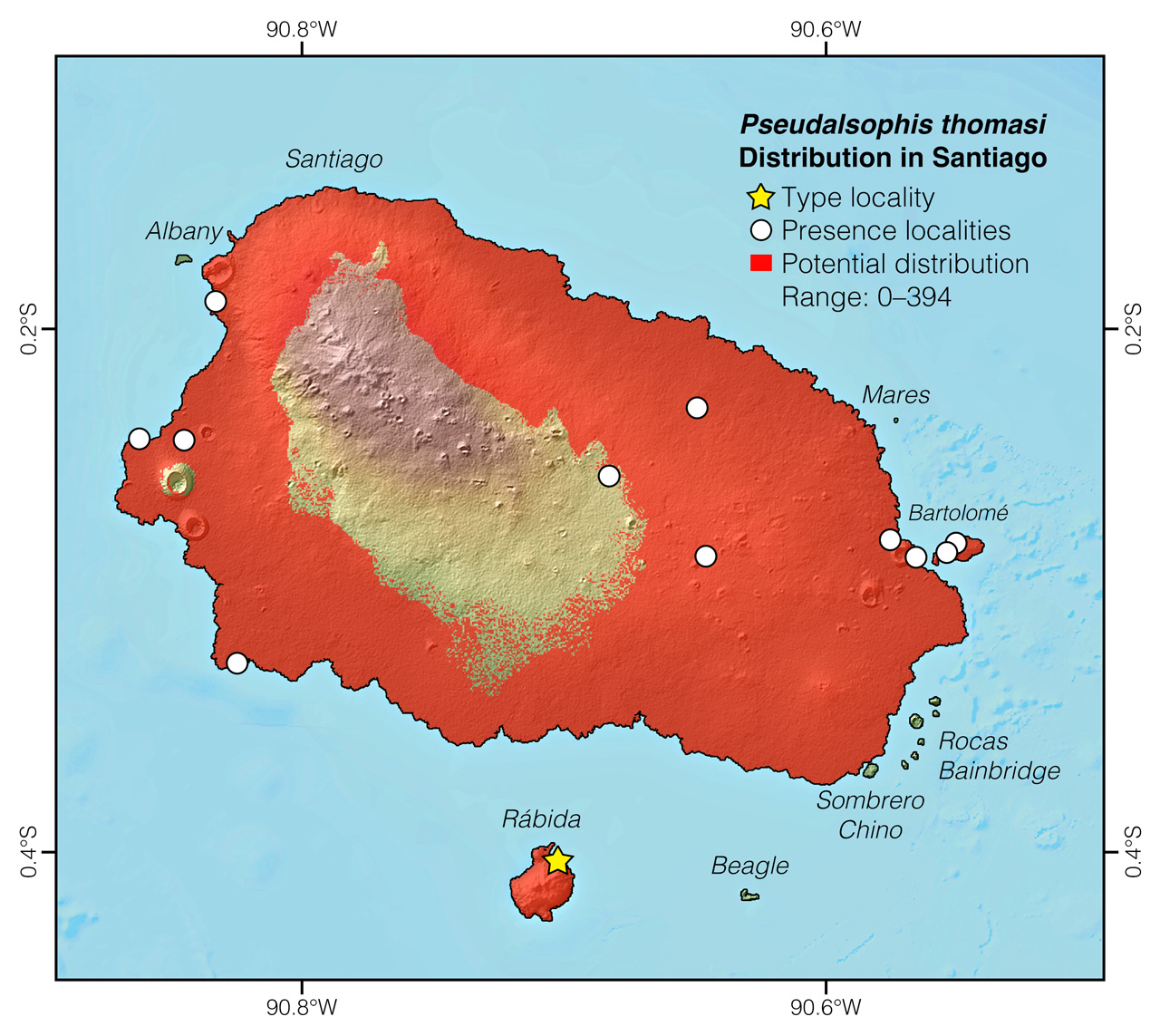Published October 10, 2019. Updated May 30, 2024. Open access. Peer-reviewed.
Thomas’ Racer (Pseudalsophis thomasi)
Reptiles of Ecuador | Serpentes | Colubridae | Pseudalsophis thomasi
English common name: Thomas’ Racer.
Spanish common names: Culebra corredora de Thomas.
Recognition: ♂♂ 98.3 cmMaximum distance from the snout to the tip of the tail. Snout–vent length=73.8 cm. ♀♀ 84.8 cmMaximum distance from the snout to the tip of the tail. Snout–vent length=65.5 cm..1 Pseudalsophis thomasi is one of two snake species occurring on Santiago and Rábida islands, and probably the only one occurring on Bartolomé.1,2 It is characterized by having a dark brown head cap that extends as a vertebral band throughout the body, bordered on each side by broad light cream or tan dorsolateral stripes (Fig. 1). This pattern differentiates it from P. hephaestus, a smaller snake having lateral black bands and supralabial scales conspicuously edged with black pigment.1,2

Figure 1: Individuals of Pseudalsophis thomasi from Cumpleaños, Santiago Island, Galápagos, Ecuador.
Natural history: Pseudalsophis thomasi is considered a common species, about ten times as abundant as the co-occurring P. hephaestus. Thomas’ Racers are diurnal and terrestrial snakes that inhabit coastal volcanic rock areas, dry grasslands, and seasonally dry forests.1–3 During the daytime, they are typically seen swiftly moving on bare soil or on lava blocks.1,2 Their activity occurs throughout most of the day, but usually not during hot midday hours.2 Galápagos racer snakes in general are mildly venomous, which means they are dangerous to small prey, but not to humans.1 The diet in P. thomasi includes lizards (Microlophus jacobii), geckos (Phyllodactylus maresi), snakes, birds, and insects.3–6 There are recorded instances of predation on members of this species, including by rats, pigs, mockingbirds, and hawks.3
Conservation: Near Threatened Not currently at risk of extinction, but requires some level of management to maintain healthy populations..2 Pseudalsophis thomasi is listed in this category because although the species is not undergoing a decline in the extent and quality of its habitat, it is known from just 10 localities and is facing the threat of predation by introduced rodents.3 Santiago Island has a long history of introduced species, but the island’s conditions are improving. Pigs were eradicated from Santiago in 1999, followed by goats in 2003, and donkeys in 2005.2
Distribution: Pseudalsophis thomasi is endemic to an area or approximately 435 km2 in Galápagos, including Santiago, Rábida, and Bartolomé islands (Figs 2, 3).

Figure 2: Distribution of Pseudalsophis thomasi in Galápagos. See Appendix 1 for a complete list of the presence localities included in the map.

Figure 3: Distribution of Pseudalsophis thomasi in Santiago Island. The star corresponds to the type locality: Rábida Island. See Appendix 1 for a complete list of the presence localities included in the map.
Etymology: The generic name Pseudalsophis comes from the Greek words pseudo (=false) and Alsophis (a genus of Caribbean snakes), referring to the similarity between snakes of the two genera.1 The specific epithet thomasi honors Robert A. Thomas, for expanding the knowledge of the systematics and taxonomy of New World snakes.1
See it in the wild: Thomas’ Racers are secretive snakes, but, with some luck, they can be seen at a rate of about once every few days at tourism sites of Bartolomé and Rábida islands. The best time to look for them is during the first hours after sunrise or right before sunset.
Special thanks to Robert Thomas for symbolically adopting the Thomas’ Racer and helping bring the Reptiles of Ecuador book project to life.
Click here to adopt a species.
Authors: Alejandro ArteagaaAffiliation: Fundación Khamai, Reserva Arlequín, Ecoruta Paseo del Quinde km 56, Santa Rosa de Mindo, Pichincha 171202, Ecuador. and Juan M GuayasaminbAffiliation: Universidad San Francisco de Quito, Quito, Ecuador.
Academic reviewers: Robert A ThomascAffiliation: Loyola University, New Orleans, United States. and Luis Ortiz-CatedraldAffiliation: Massey University, Palmerston North, New Zealand.
Photographer: Jose VieiraeAffiliation: Tropical Herping (TH), Quito, Ecuador.,fAffiliation: ExSitu, Quito, Ecuador.
How to cite? Arteaga A, Guayasamin JM (2024) Thomas’ Racer (Pseudalsophis thomasi). In: Arteaga A, Bustamante L, Vieira J (Eds) Reptiles of Ecuador: Life in the middle of the world. Available from: www.reptilesofecuador.com. DOI: 10.47051/OKHJ6810
Literature cited:
- Zaher H, Yánez-Muñoz MH, Rodrigues MT, Graboski R, Machado FA, Altamirano-Benavides M, Bonatto SL, Grazziotin FG (2018) Origin and hidden diversity within the poorly known Galápagos snake radiation (Serpentes: Dipsadidae). Systematics and Biodiversity 16: 614–642. DOI: 10.1080/14772000.2018.1478910
- Arteaga A, Bustamante L, Vieira J, Tapia W, Guayasamin JM (2019) Reptiles of the Galápagos: life on the Enchanted Islands. Tropical Herping, Quito, 208 pp. DOI: 10.47051/AQJU7348
- Cisneros-Heredia DF, Reyes-Puig C (2023) Natural history and conservation of the Galápagos snake radiation. In: Lillywhite HB, Martins M (Eds) Islands and snakes. Oxford University Press, 158–182. DOI: 10.1093/oso/9780197641521.003.0009
- Fritts TH, Fritts PR (1982) Race with extinction: herpetological notes of J. R. Slevin’s journey to the Galápagos 1905–1906. Herpetological Monographs 1: 1–98.
- Ortiz-Catedral L, Christian E, Skirrow MJA, Rueda D, Sevilla C, Kumar K, Reyes EMR, Daltry JC (2019) Diet of six species of Galapagos terrestrial snakes (Pseudalsophis spp.) inferred from faecal samples. Herpetology Notes 12: 701–704.
- Sollis HE (2020) Conservation of the Central Galapagos Racer (Pseudalsophis dorsalis) in the Galápagos Islands, Ecuador. MSc thesis, Massey University, 257 pp.
Appendix 1: Locality data used to create the distribution map of Pseudalsophis thomasi in Ecuador (Fig. 2). Go to the section on symbols and abbreviations for a list of acronyms used. Asterisk (*) indicates type locality.
| Country | Province | Locality | Source |
| Ecuador | Galápagos | Bahía Sullivan | Thomas 1997 |
| Ecuador | Galápagos | Crab point | Thomas 1997 |
| Ecuador | Galápagos | Cumpleaños | Arteaga et al. 2019 |
| Ecuador | Galápagos | Cumpleaños, 8 km N of | iNaturalist; photo examined |
| Ecuador | Galápagos | Highlands of Santiago Island | Cisneros-Heredia & Reyes-Puig 2023 |
| Ecuador | Galápagos | Isla Bartolomé, northern slope | iNaturalist; photo examined |
| Ecuador | Galápagos | Isla Bartolomé, western slope | Thomas 1997 |
| Ecuador | Galápagos | James Bay (=Puerto Egás) | Zaher et al. 2018 |
| Ecuador | Galápagos | Minas de sal | iNaturalist; photo examined |
| Ecuador | Galápagos | N side beach | Thomas 1997 |
| Ecuador | Galápagos | Playa Dorada (in Santiago) | Arteaga et al. 2019 |
| Ecuador | Galápagos | Rábida Island* | Zaher et al. 2018 |